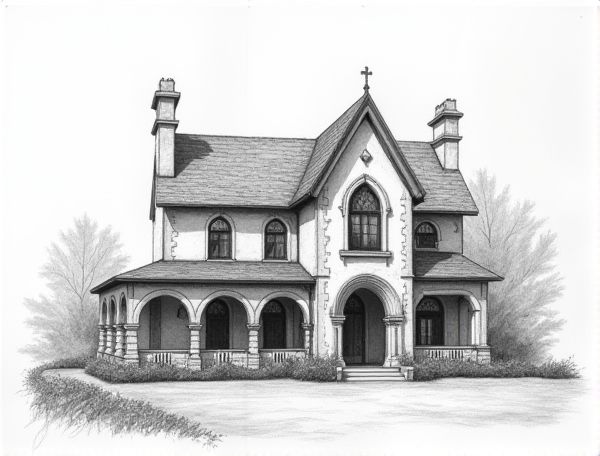
Photo illustration: Gothic Revival home design with ogee arches
Gothic Revival home design featuring ogee arches creates a dramatic and elegant ambiance, reflecting medieval craftsmanship with its characteristic pointed curves and intricate detailing. Explore the full article to discover how your space can embody this timeless architectural style.
Introduction to Gothic Revival Home Design
Gothic Revival home design emphasizes pointed arches, intricate tracery, and steeply pitched roofs that evoke medieval European architecture. This style incorporates decorative elements such as finials, lancet windows, and buttresses, creating a dramatic and historic aesthetic ideal for those seeking a distinctive and elegant residence.
Historical Origins of the Gothic Revival
The Gothic Revival architectural style emerged in the late 18th century, inspired by medieval Gothic cathedrals and structures characterized by pointed arches, ribbed vaults, and flying buttresses. This design movement gained prominence during the 19th century, especially in Europe and North America, as architects and designers sought to revive the romanticism and craftsmanship of the Gothic period. Key figures like Augustus Pugin and John Ruskin championed the style, emphasizing its moral and aesthetic values in both residential and ecclesiastical buildings.
Key Features of Gothic Revival Architecture
Gothic Revival architecture is characterized by pointed arches, ribbed vaults, and flying buttresses that create a dramatic vertical emphasis. Ornate tracery, steeply pitched roofs, and detailed stone or wood carvings enhance the intricate aesthetic typical of 19th-century ecclesiastical and residential designs.
The Significance of Ogee Arches in Gothic Design
Ogee arches play a crucial role in Gothic design, characterized by their double-curved, S-shaped form that adds elegance and intricate detail to architectural features. Their pointed apex not only enhances structural stability but also emphasizes verticality, a hallmark of Gothic style, creating an impression of height and grandeur in your home. Incorporating ogee arches in your design elevates aesthetic appeal while preserving historical authenticity and craftsmanship.
Incorporating Ogee Arches into Modern Interiors
Incorporating ogee arches into modern interiors enhances architectural elegance by blending traditional Moroccan and Gothic influences with contemporary design elements, creating visually striking focal points that frame doorways, windows, or alcoves. This design choice adds depth and curvature to minimalist spaces, promoting a sense of fluidity and timeless sophistication that complements both neutral color palettes and bold, eclectic decor styles.
Materials Commonly Used in Gothic Revival Homes
Gothic Revival homes predominantly feature materials such as limestone, sandstone, and brick, which enhance their textured, historic facade. Ornate wooden elements are often crafted from oak or pine, contributing to the intricate carvings and detailed interiors. Stained glass windows with vibrant colors and lead cames remain a hallmark, emphasizing the style's authentic medieval appearance.
Color Palettes and Decorative Elements
Color palettes featuring earthy tones like terracotta, olive green, and warm beige enhance natural aesthetics and create a cozy ambiance, while incorporating contrasting shades such as navy blue or charcoal grey adds visual depth to interiors. Decorative elements including textured throw pillows, brass light fixtures, and artisanal ceramics provide tactile interest and elevate the overall design by blending functionality with artistic appeal.
Furniture and Lighting for a Gothic Revival Aesthetic
Furniture in a Gothic Revival home features intricately carved dark woods, pointed arches, and ornate details that evoke medieval craftsmanship, while lighting often includes wrought iron chandeliers, lantern-style sconces, and stained glass lamps that cast dramatic shadows. Rich textures, heavy fabrics, and dim, warm illumination enhance the mysterious and romantic atmosphere characteristic of the Gothic Revival aesthetic.
Landscaping for Gothic Revival Exteriors
Landscaping for Gothic Revival exteriors emphasizes dramatic, vertical elements and intricate detailing that complement the architecture's pointed arches and ornate woodwork. Incorporate tall, slender evergreens, wrought iron fencing, and climbing ivy to enhance the historic, cathedral-like ambiance of your garden. Your outdoor space becomes a seamless extension of the Gothic Revival style, blending natural beauty with architectural elegance.
Tips for Preserving and Restoring Gothic Revival Homes
Careful attention to authentic materials such as limestone, wood moldings, and stained glass is essential in preserving your Gothic Revival home's historic character. Consulting with restoration experts who specialize in period craftsmanship ensures that intricate details like pointed arches, tracery, and finials are replicated accurately. Regular maintenance of the steeply pitched roofs and ornate exterior trim prevents damage and preserves the architectural integrity for future generations.
 homedesy.com
homedesy.com